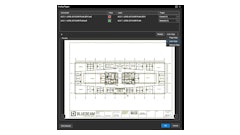
Artificial intelligence (AI) is poised to revolutionize the way the construction industry plans, executes, and manages large infrastructure projects by allowing organizations to see the bigger picture. Four in five industry professionals agree that when used to its full capability, artificial intelligence – AI-driven strategic project insights – has a significant impact on project outcomes, according to InEight’s 2023 Global Capital Projects Outlook.
Similarly, most construction industry professionals recognize the importance of digital technologies (60%) and data collection, analytics, and AI-driven insights (48%) to drive growth.
Yet surprisingly, despite most organizations facing supply chain challenges and skills and staff shortages that are a risk to growth, only half (50%) are using some form of artificial intelligence and machine learning to combat these business disruptions. Likewise, only a handful of those organizations are using AI in its most advanced form – to generate new knowledge.
For some construction industry professionals, it can be difficult to understand the use cases and benefits of AI, when so much of the work is physical. This is often compounded if an organization is still getting some of the more foundational technologies in place. However, with AI evolving at pace, the productivity and growth gains that construction organizations stand to make through its adoption is becoming increasingly clear – those that have seen productivity remain static for the last 40 plus years are finally seeing improvements.
Staff and Skills Shortages
One of the key benefits of AI to the construction industry is its potential to take on staff shortage issues in the industry in a variety of unique and creative ways, from automating existing manual tasks like report generation and timecard processing, to safety inspections and purchasing. The looming staff and skills shortage is weighing heavy on the minds of many industry professionals, with the Outlook revealing that it is now considered the biggest risk to growth (42%), ahead of economic stagnation (40%).
While traditionally project planning has been the domain of subject matter experts in specific roles such as estimators, work planners, and schedulers, the advent of large language models means more people can find information and make decisions without having to know how to navigate the software. Understandably, there is skepticism around the adoption of advanced technologies such as this. Its novelty means experimentation, iteration, and repetition are required to build understanding, confidence, and expertise in AI applications. And, as with digital transformation more broadly, data is also critical to successful implementation.
AI Relies on Quality Data
Dynamic insights, gained using predictive models powered by AI, can help employees to make data-informed decisions which typically lead to enhanced project outcomes. At present, historic project data is being used about half (48%) the time to improve project outcomes. According to a recent Microsoft study, for every $1 a company invests in AI, it is realizing an average return of $3.5X, underscores AI’s demonstrable business value.
AI enables rapid analysis, pattern discovery and evaluation of scenarios based on project data in the context of the bigger picture. It can then suggest least risk alternative approaches that not only improve individual project outcomes but lead to better efficiency and productivity overall.
To gain the most effective insights, a focus on the quality and volume of data is necessary. Data that is too little or too poor in quality will yield very little. One observed barrier is the disconnect that is often common between those that enter the data that AI relies upon, and those that use AI directly. Without understanding the importance of inputting quantities, dates, locations etc., data can sometimes be missing or inaccurate, which in turn renders organizations unable to derive the full value from their AI investment. All employees need to have a sense of what an organization’s AI adoption is driving toward, so they can better understand why mundane data entries tasks suddenly have renewed importance.
A Focus on the User
Part of this will also likely come with time, as the workforce shifts generationally to those that are naturally more tech savvy, although there is also a role for AI developers to remove the barriers to capturing high quality data and focus on user experience and benefits. When surveyed by the Outlook, most construction industry professionals would welcome technologies that would give them real-time insights (57%) and bring them closer to operational reality (51%), as well as automating parts of their role to save time (47%).
Finally, some employees are wary of how it may change their day-to-day roles. The message to them must be clear – AI complements the organization’s human intelligence, but it is not a replacement for it. It would be possible for a human to generate many of the same insights by dedicating their life to combing through the millions of data points generated by each construction project – but why would you want to when AI can create space for human intelligence to be applied much more creatively? It’s also about history. Every year, the number of data points collected increases, but its collection is meaningless without analytics.
This is Only the Beginning
The construction industry stands at the precipice of a transformative era fueled by artificial intelligence and ever-increasing pressure to build utilities, transport, energy, and housing to meet the needs of a growing population. While the industry has just begun scratching the surface of AI's potential, the statistics show a growing recognition of its opportunities and benefits.
From data collection and analytics to artificial intelligence and dynamic project insights, AI has the power to revolutionize project outcomes and drive growth. However, challenges such as skepticism, data quality, and the need to develop uses cases remain. By embracing AI, the construction industry could revolutionize project outcomes and transform itself from being a ‘cool science experiment’ to the lifeblood of many organizations.



























